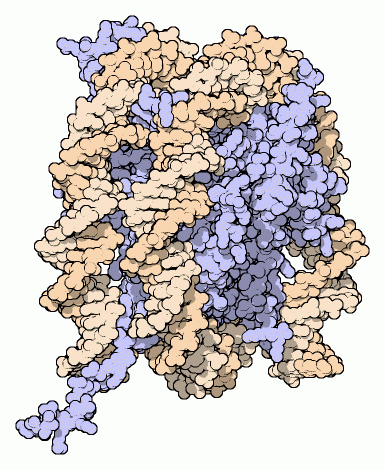|
Inhaltsübersicht | Nanomaschinen | Moleküle | Programme | Kurse | Fun | Links |
||
| > |
Nucleosome

A Molecular Librarian
This is an auspicious time for molecular biology. The wave of knowledge that began in 1944 with Avery's discovery of DNA as the genetic material, which lead naturally to the atomic model of DNA proposed by Watson and Crick, and continued through detailed experiments to determine the genetic code, is now cresting with the release of the first draft of the human genome. This molecular text, written through billions of years of evolution, will provide untold insights into the molecular processes that underlie every aspect of our lives.
Each of our cells (or more correctly, nearly all of our cells) contains a copy of this genome, encoded in three billion base pairs of DNA. This information is precious and must be carefully guarded. Inside our cells, a collection of repair enzymes corrects chemical changes inflicted on the strands by environmental insults. But the delicate strands must also be protected from physical damage. This is the job of nucleosomes.
A Paradox
The job of the nucleosome is paradoxical, requiring it to perform two opposite functions simultaneously. On one hand, nucleosomes must be stable, forming tight, sheltering structures that compact the DNA and keep it from harm. On the other hand, nucleosomes must be labile enough to allow the information in the DNA to be used. Polymerases must be allowed access to the DNA, both to transcribe messenger RNA for building new proteins and to replicate the DNA when the cell divides. The method by which nucleosomes solve these opposed needs is not well understood, but may involve a partial unfolding of the DNA from around the nucleosome, one loop at a time, as the information in the DNA is read.
Wagging Tails
Apart from their function of safely packaging DNA, nucleosomes also modify the activity of the genes that they store. Each nucleosome is composed of eight "histone" proteins bundled tightly together at the center (shown here in blue), encircled by two loops of DNA (shown here in orange). The histone proteins, however, are not completely globular like most other proteins. They have long tails, which comprise nearly a quarter of their length. The tails extend outward from the compact nucleosome, reaching out to neighboring nucleosomes and binding them tightly together. The nucleus contains regulatory enzymes that chemically modify these tails to weaken their interactions. In this way, the cell makes particular genes more accessible to polymerases, allowing their particular information to be copied and used to build new proteins.
Next: Opposites Attract
Last changed by: A.Honegger,